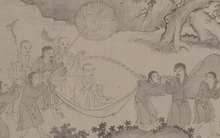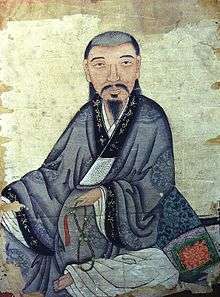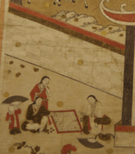Áo giao lĩnh
The áo cổ chéo (Giao lãnh y, 交領衣, lit. "cross-collared robe") was a traditional cross-collared robe worn by Vietnamese before the 19th century. During the Nguyen dynasty, it was replaced by the áo dài and became obsolete.[1][2]
- Áo cổ chéo as depicted in various paintings and photos:
 Tran dynasty robes as depicted in a section of a 14th-century scroll
Tran dynasty robes as depicted in a section of a 14th-century scroll Portrait of Prince Tôn Thất Hiệp from the 17th century. He wears a cross-collared robe (áo cổ chéo) which was commonly worn by Vietnamese aristocrats before the 19th century
Portrait of Prince Tôn Thất Hiệp from the 17th century. He wears a cross-collared robe (áo cổ chéo) which was commonly worn by Vietnamese aristocrats before the 19th century "Giảng học đồ" (Teaching), 18th century, Hanoi museum of National History. Scholars and students wear cross-collared gowns (áo cổ chéo) - unlike the buttoned áo dài
"Giảng học đồ" (Teaching), 18th century, Hanoi museum of National History. Scholars and students wear cross-collared gowns (áo cổ chéo) - unlike the buttoned áo dài Typical 5-part Áo cổ chéo of the Nguyễn dynasty
Typical 5-part Áo cổ chéo of the Nguyễn dynasty
See also
References
- ↑ Vu, Thuy (2014), "Đi tìm ngàn năm áo mũ", Tuoi Tre, retrieved June 16, 2015
- ↑ Unknown, T.Van (2013), "Ancient costumes of Vietnamese people", Vietnamnet, retrieved June 16, 2015
This article is issued from Wikipedia - version of the 8/11/2016. The text is available under the Creative Commons Attribution/Share Alike but additional terms may apply for the media files.